This Very Tree: A Visit with Sean Rubin
 August 17th, 2021 by jules
August 17th, 2021 by jules
And each year, I was one of the first trees to blossom.
My flowers let everyone know that spring was coming.”
(Click spread to enlarge)
Sean Rubin’s This Very Tree (Henry Holt, May 2021), another 2021 picture book offering that marks the 20th anniversary of 9/11, is based on, as Sean explains below, research around trauma and its treatment. Dr. Lucy Guarnera (Sean’s wife) taught him, as he notes in the book’s acknowledgments, what it would look like for the survivor tree — the Callery pear tree planted near the Towers in the 1970s, which survived the Towers’ falls — to “experience its trauma and recovery as a human would.”
Opening with an excerpt from E. B. White’s Here Is New York, the book tells the tree’s story of 9/11, and its recovery and rebirth, in a reverent first-person voice. It addresses the day’s tragedy in an age-appropriate way; is paced with a mesasured and lovely gentleness when the tree, after being found in the rubble, is sent away to heal (“I was grateful to be somewhere quiet”); and is anchored by Sean’s detailed, research-driven illustrations in which color and shadow communicate great emotion. (One of the book’s delightful design details: The book’s typefaces were chosen for their appeaance on the cornerstone of the current One World Trade Center.)
Sean visits today to talk about the book, share some process images, and explain why the book never explicitly mentions 9/11 in the narrative itself. I thank him for visiting.
Jules: I’d like to start by asking about the E.B. White poem that opens this book. Did that come first or last for you?
Sean: Oh my goodness, what a great first question. The quote definitely came first. Honestly, I’ve been obsessed with that quote for years. I think, back in 2011, I put it on my Instagram account for the tenth anniversary of 9/ll. And interestingly enough, the willow tree E.B. White was writing about lived until around 2010.
When I was invited to submit a proposal for this book, I realized I wouldn’t be able to write an entire manuscript by the deadline. But I knew the quote and I already knew I wanted to (try to!) write something that recaptured some of the emotion White had captured, so I included the quote as the second page of proposal (as pictured below).
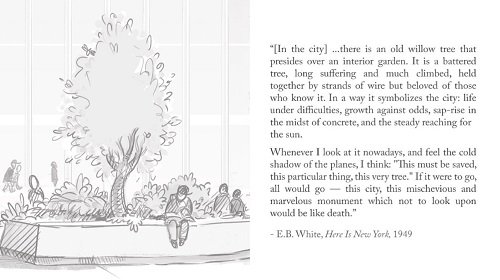
Although it’s not originally a poem, the art director, Jen Keenan, formatted it to look that way. White’s prose is so spare and lyrical at the same time; it totally works in that format. We included the quote at the beginning of the book for the same reason I included it at the beginning of my pitch: By getting readers to understand how the New York community felt about that willow tree, we hoped they would better understand how the community feels about the Survivor Tree — and about the whole city, really. It’s a sort of lens through which to read the rest of the story.
Jules: You dedicate the book, in part, to your cousin Stephen. Is there a 9/11 story there, and if so and if it’s too personal, you certainly don’t have to share.
Sean: There’s an allusion to the story in the dedication. My Uncle Stephen (older cousins are often called “uncle” in my family) worked with New York City Fire Department as a safety inspector for a number of years. After 9/11, he was assigned to the pile (what the workers there called Ground Zero) as a sort of safety sheriff for the area. When I was officially offered the book, I actually called him to ask for his blessing. That conversation was very meaningful to me for a number of reasons. For one thing, it was the first time I had really asked him about his experience working there. His descriptions of the pile — and what it would be like for the tree to be buried there — were haunting. They ultimately inspired the spread where the tree is in the dark. The book would be much poorer without this insight and his willingness to talk about a difficult set of memories. I’m grateful to him for both.
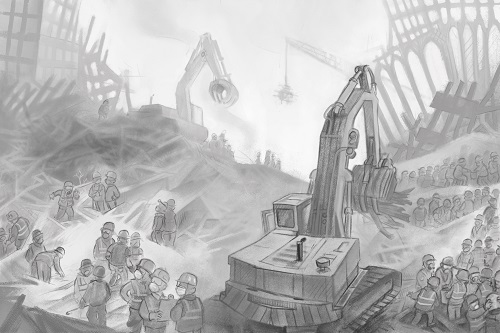
(Click image to enlarge)
Jules: Can you talk about how the book draws heavily on research about the nature of trauma? Your wife, a clinical psychologist, received training at a research center in South Carolina, and their research informed this book, yes?
Sean: Lucy has specialized training in trauma assessment and treatment from the National Crime Victims Research and Treatment Center in Charleston, South Carolina. Our family spent a year there before she completed her PhD in 2019. I remembered that she found that training to be very effective (and affecting), so at one point early in the writing process, I had hit a little writer’s block and went to talk to her about it.
I already knew the story should somehow acknowledge traumatic experience, but during that conversation I realized the book wasn’t going to work unless the tree’s trauma actually determined the entire narrative arc. So I asked Lucy, “If the tree was a patient that came to your practice, what would you expect it to say? How would it feel? What would be its trajectory in therapy?” I quickly wrote down her answers on a couple of Post-it notes.
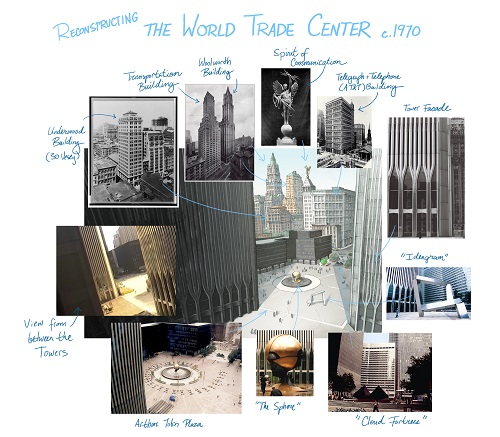
(Click to enlarge)
There were a number of insights that were taken directly from Lucy’s training and experience treating patients. For example, the tree withdraws from others; it’s sensitive to reminders of what happened; it feels both excited and anxious about its return to Manhattan. For many trauma survivors, community is a defining part of the recovery process, so our tree’s reliance on other trees became important.
The idea I’m probably most fond of is that the tree had a “job.” I wanted to communicate that the tree had a purpose and daily activities that were interrupted by the attacks, so that its recovery could be tracked by the way the tree thinks about that purpose — and how that purpose changes over time. Of course, the tree was planted in Manhattan’s Financial District, so I imagined it had adopted a business perspective, hence being proud of its “job.”
Jules: Did you labor over how to depict the actual tragedy (the collapse of the Towers) in such a way that is honest? You handle it well. You hear a lot of people say such heavy topics shouldn’t exist in picture books (which I disagree with – and clearly you do too).

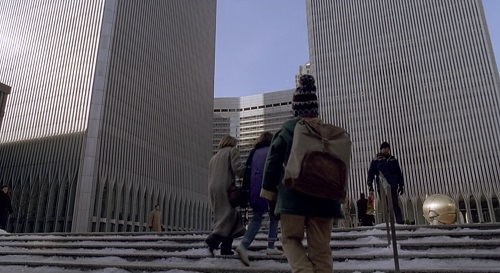

(Click first two to enlarge)
Sean: I appreciate that. More than anything I tried to capture the chaos. In that moment, everyone was confused and scared, and it was impossible to really understand what was happening. I took forever on that illustration. I finished it last after working on the art, piecemeal, for months. But I was getting to the deadline, so I delivered what you see in the book. A day after the deadline, I called my editor, Christian Trimmer, to say I was recalling that spread. I told him I didn’t like the art and that was making me uncomfortable. He paused and said something like, “Sean, it’s supposed to make you uncomfortable. It’s doing its job.” I realized he was right.
So, I think the topic is heavy, but I hope the book is a gentle way of approaching it. Picture books are a medium that can be both gentle and genuinely surprising. We rely on page-turns as a storytelling device, after all, although I know some readers may expect every picture book to be gentle all the time. I think that may shortchange the medium. Picture books are remarkable for their ability to tell virtually any type of story and to tell difficult stories in ways that are appropriate for younger ages. I love that about picture books, and I hope to make more books with a startling spread or two, whether their topics are heavy or not.
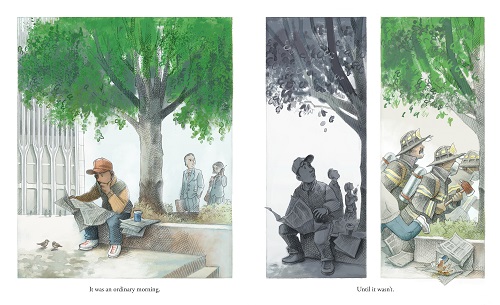
(Click spread to enlarge)
Jules: Yes, I love how your use of off-kilter panels in that spread [not pictured here] communicates so much of the confusion and chaos. And the use of the panels in the “it was weeks before they found me” spread, and the perspective you provide there, are effective. It must have been such a joy to paint those final spreads with all the many trees and what seems like every shade of green! It is so beautiful to see.
Sean: I was thinking about collapse and falling with those panels, of course, but also broken glass. I wound up studying layouts for action scenes in superhero and fantasy comics to make that work, especially some of Ramón Pérez’s art in Jim Henson’s Tale of Sand, where he really perfects using panels to show many things happening all at once.
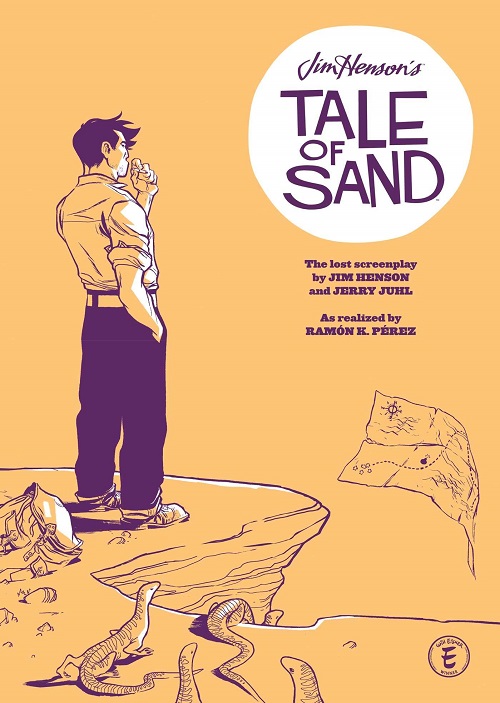
The “found me” spread was part of my original proposal, and it’s still one of my favorites. Panels are really helpful for covering longer stretches of time, and that spread is one example. Originally, when the tree is looking up, it was about seeing that spot of light and the light getting brighter and bigger over the spread. But we could do a lot with depth and distance in those images too, so the top of the pile getting closer became the focus as well.
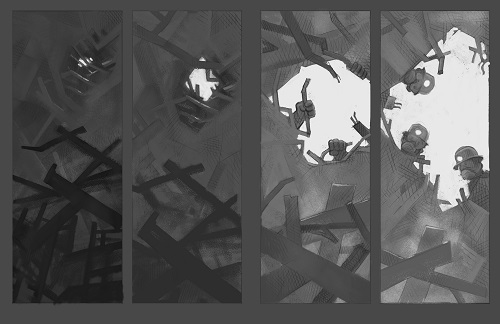
(Click image to enlarge)
In regards to those final spreads, thank you! Green is my favorite color (which I don’t think is always apparent from my art, I’ll admit). It was great to “mix” a number of greens in Photoshop and layer them to create the leaves, and I think some orange and periwinkle snuck in as well. I learned a ton about painting trees while working on The Passover Guest, and it was a joy to get back into that painting mindset. I love drawing, but there’s nothing on earth like painting. The tree is starting to relax at that point, and so was the illustrator.

(Click to enlarge)
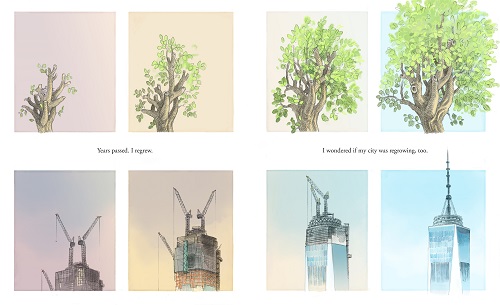
I wondered if my city was regrowing too.”
(Click spread to enlarge)
Jules: Now I have to ask: What’d you learn about painting trees on The Passover Guest?
Sean: Ha! Well, cross-hatching is good for a lot of things, but for some reason when I try to crosshatch trees, the leaves (or flowers) feel way too heavy. In Bolivar, I started to experiment with digital watercolor for tree tops, and I liked that effect, but it was a bit too cartoony for The Passover Guest. When I started to paint the cherry blossoms for The Passover Guest, I was still doing a lot of digital watercolor but eventually added gouache and crayon to the trees to create different kinds of weight and levels of transparency — and also value differences (how light or dark something is). By the time I got to This Very Tree, I was using this “digital mixed media” approach extensively.
The result may have a kind of abstract expressionism vibe, for better or worse, but for me, it captures the movement and visual complexity of a tree better than cross-hatching can. At least I hope it does. One of the oddities of being an illustrator is that you often have to figure out your craft on the job. So you can definitely see a development in how I paint trees if you look at my books from, say, 2017 till now. It’s only mildly embarrassing!
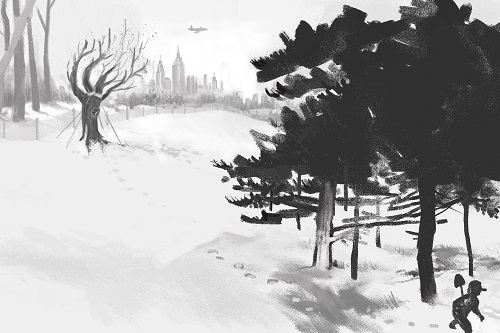
(Click to enlarge)
Jules: This book doesn’t explicitly mention 9/11 in the actual narrative. (It shows up in the backmatter.) Can you talk about why?
Sean: When we were talking about the tree’s voice, a big part of the conversation centered on what she would know and what she wouldn’t know. I thought she’d know she lived in New York, but I didn’t think she’d have too much of a sense of what state or country she lived in. Similarly, I didn’t think she’d have any sense of geopolitics or what terrorism is — or even understand airplanes. For her, airplanes cast shadows and that’s it. All this is to say that the book is from the perspective of the tree, so the explanation of 9/11 is also limited to the tree’s experience. And her experience is very immediate.
This meant the book could focus on 9/11 as a personal tragedy, something that occurred to individuals and families, and as a local tragedy, something that had an specific effect on particular communities. I’m concerned the local/personal narrative of 9/11 has become lost — or at least very overshadowed. I think many of us (myself included) have difficulty knowing how to discuss 9/11, because we are uncomfortable with the politics surrounding it. My hope is that by focusing on the local and the personal, This Very Tree creates a space for children to ask questions and for adults to answer. But the book avoids easy answers and simple explanations because, frankly, I don’t think they exist.
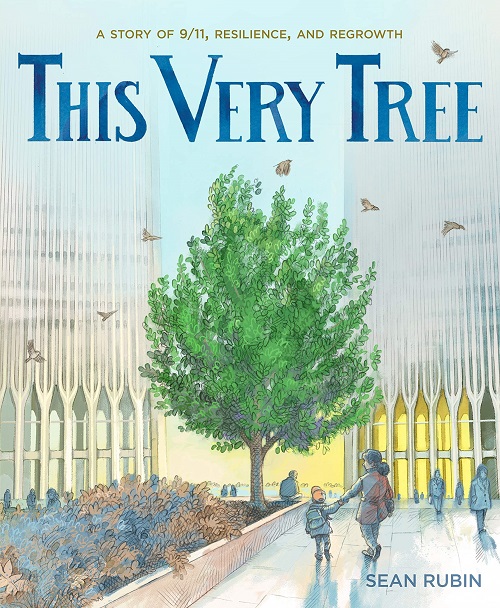
THIS VERY TREE. Copyright © 2021 by Sean Rubin. Final illustrations reproduced by permission of the publisher, Henry Holt and Company, New York. All other images reproduced by permission of Sean Rubin.
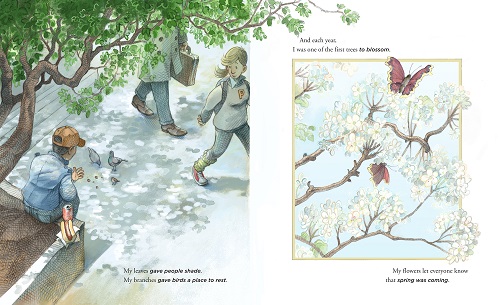

[…] THIS VERY TREE. Copyright© 2021 by Sean Rubin. Final illustrations reproduced by permission of the publisher, Henry Holt and Company, New York. All other images reproduced by permission of Sean Rubin. Posted: August 17th, 2021 by jules […]